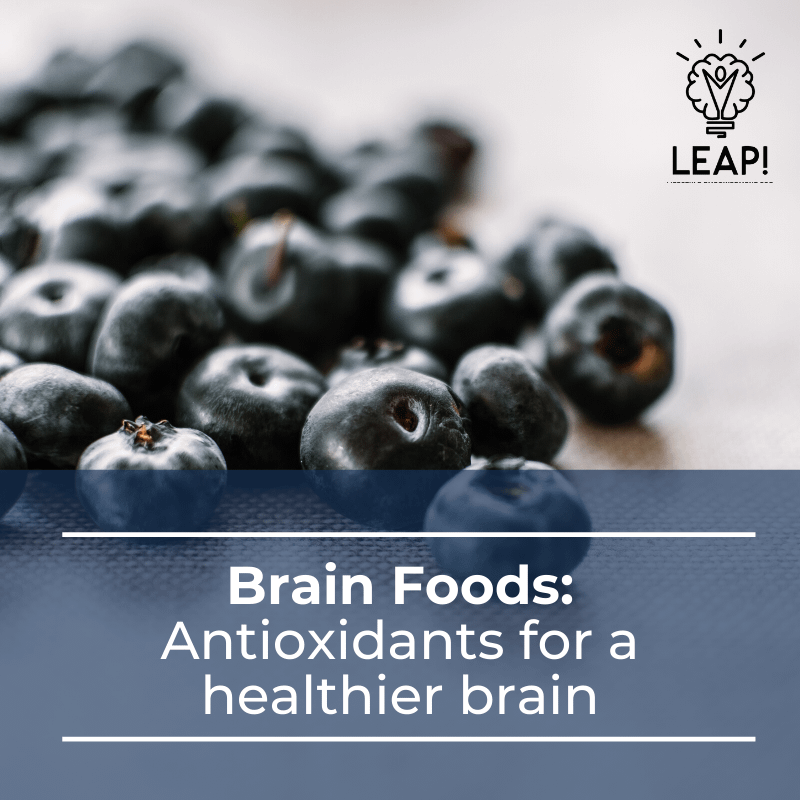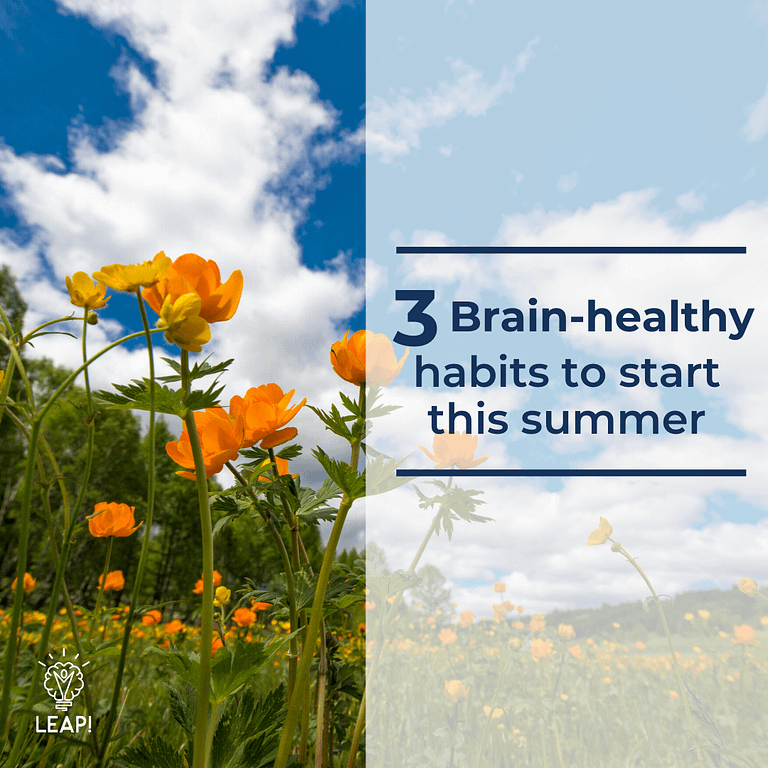Antioxidants. You’ve likely heard that term before, and you likely know that they are good for us—but what are antioxidants and how are they good for us?
If you attended our LEAP! class on antioxidants with our Registered Dietitian Rachel Sandoval earlier this month, you now have a good understanding of how to optimize your antioxidant intake, as well as some fun facts about antioxidant favorites like wine and chocolate.
If you didn’t get the chance to come to our class, however, we’re here to fill you in on all things antioxidant—what antioxidants are, how they contribute to brain health, and what food sources they come from.
If you did attend the class, keep reading—we’re going into even more detail here.
Before we discuss antioxidants, we need to define a few terms.
Oxidation occurs naturally in the body as a part of energy production. It’s a chemical reaction that involves the loss of electrons¹. Cell signaling and exercise are two of the many processes that naturally cause oxidation in our bodies.
Reactive oxygen species (ROS) are molecules derived from oxygen that contain an uneven number of electrons, making them very reactive. ROS need to balance out their electrons. Until they do, they can bounce around in our cells and make a mess. Some degree of ROS activity is a normal part of how our bodies function and generate energy, but too much can be a problem. When we have too many ROS or other forms of oxidation, oxidative stress can occur¹.
Oxidative stress is caused by an imbalance between ROS and antioxidants, or by an excess of ROS¹. During normal oxidation, ROS and antioxidants work together to help fight pathogens, which helps maintain our immune system.
However, if our body undergoes too much oxidative stress, ROS can target essential parts of our cells, such as the DNA and the mitochondria. Additionally, ROS can cause damage to healthy fats and proteins in our body¹.
According to the research, damage caused by oxidative stress is a contributor to the development of many chronic illnesses, including Alzheimer’s disease¹.
The brain may be particularly vulnerable to oxidative stress due to its incredibly high demands for oxygen and energy production. It consumes about 20% of the body’s oxygen! The brain also has a high concentration of fats that may be easily oxidized².
We don’t fully understand the role of oxidative stress in the development of AD, but it may have something to do with the mitochondria. These are the little powerhouses of our cells, responsible for energy production. They are highly susceptible to oxidative damage, and problems with the mitochondria may play a significant role in Alzheimer’s disease. Regardless of the reasons, it seems that a healthy diet rich in antioxidant foods (think fruits and veggies) is good for our brains.
One recent large study explored the role of flavonols (a class of phytonutrients with many antioxidant compounds). They found that those who ate the most dietary flavonols experienced a 48% lower rate of developing Alzheimer’s disease compared to those who ate the least flavonols³. A compound called kaempferol, which is found in tea, apples, strawberries, beans, kale, broccoli, spinach, and other fruits and vegetables, seemed to be the most potent.
So how do antioxidants help reduce the effects of oxidative stress?
Antioxidants are compounds that prevent or delay the process of oxidation¹. This can occur in a few different ways:
- antioxidants can donate electrons to ROS, resulting in stabilization;
- antioxidants can block or capture ROS that are formed;
- and antioxidants can help repair or remove harmful molecules.
Many antioxidants can be found in fruits, vegetables, nuts, olive oil, and even wine, coffee, and chocolate—all of which are part of the Mediterranean Diet we recommend, which emphasizes fruits, vegetables, and healthy fats.
Let’s look at some of the foods in these groups, focusing on the specific antioxidants they can offer!
Berries
Berries are rich in anthocyanins, which belong to a class of antioxidants called phenolic compounds⁴. Anthocyanins are anti-inflammatory and give berries their red, blue and purple colors.
Anthocyanins are powerful protectors at the cellular level. Research shows that anthocyanins and other similar compounds in berries can help block certain types of ROS that contribute to AD⁴.
In recent research, it has been found that blueberry, cranberry, and strawberry consumption can help contribute to higher levels of serum antioxidant capacity⁴. Additionally, one study suggested that berry consumption can help reduce cognitive deficits in adults with mild cognitive impairment (MCI).
Add berries to your diet by adding them to your oatmeal, snacking on a yogurt parfait, or pairing them with nuts!
Green Vegetables
Green vegetables are packed with antioxidants. Cruciferous vegetables, such as broccoli, brussel sprouts and cabbage, contain antioxidants called carotenoids⁵. Carotenoids contain Vitamin A, which promotes a healthy immune system. Because Vitamin A is fat soluble, sources of this antioxidant are most beneficial when paired with a healthy fat, such as olive oil⁶.
Green, leafy vegetables such as spinach and kale are also sources of carotenoids, and also have a high content of polyphenols and flavonoids, two other antioxidants⁵.
Aim to fill half your plate with green veggies for an antioxidant dose!
Nuts
Nuts are powerful foods packed with healthy fat, protein, and antioxidants. Walnuts, in particular, have a very high antioxidant level—rich in polyphenols, which help protect against diabetes, high blood pressure, and cancer⁷ ⁸. Other nuts such as pecans, peanuts, pistachios, hazelnuts, almonds, macadamias, and cashew nuts each contain their own combination of antioxidants such as resveratrol, flavonoids, and catechins, which we’ll discuss more⁷.
Are nuts and seeds part of your regular diet? If they aren’t, we suggest aiming for at least 2 servings per week. (One serving is 1/4 cup, or one small handful.) Choose lightly salted or unsalted nuts over varieties high in sodium. Nuts are the perfect mid-morning or afternoon snack, helping you stay full before your next meal!
Olive Oil
Polyphenols in olive oil help reduce oxidative stress, which may contribute to reduced risk of heart disease, diabetes, and metabolic syndrome⁹.
Olive oil is an essential component to the Mediterranean diet we recommend for a brain-healthy lifestyle. We suggest you aim for at least 2 tablespoons per day—choosing extra virgin olive oil in a dark-colored bottle for optimum quality.
Wine
Wine and grapes are also an excellent source of polyphenols. (Exciting news, right?) Resveratrol and catechins are also present in wine. These compounds, found in the skin of grapes, have anti-cancer properties⁸.
Different types of wine will have different levels of antioxidants, however. Dry, red wines have a higher antioxidant capacity than sweet, white wines.
And let’s not forget that alcohol should be consumed in moderation. As part of the Mediterranean diet, it’s recommended that women limit their intake to one drink per day and men no more than two drinks per day. Remember that one drink of wine is a five-ounce glass.
If alcohol is not already part of your regular diet, we don’t encourage you to start or increase your consumption. Please check with your doctor if you have concerns about drinking alcohol.
Coffee
The relationship between caffeine and AD is unclear, but some studies suggest that moderate caffeine intake may help reduce the risk of dementia¹º. The antioxidant compounds found in coffee are polyphenols, and their amount depends on the way the coffee is brewed¹¹. Remember that the caffeine content in coffee can also vary.
We suggest having more caution with unfiltered coffee (e.g. French press coffee), as it has a higher concentration of compounds known as diterpenes, which may increase LDL cholesterol levels¹¹.
Additionally, we advise you to be mindful of your intake of caffeine—limiting to no more than 200mg in one sitting (about 10 oz. of coffee) and no more than 400mg in a day (about 20 oz). Excess creamer and sugar can drastically affect the nutritional quality of your cup of coffee, too, so don’t forget to take your choice of sweeteners into consideration.
Are there certain individuals who should avoid coffee consumption? Pregnant women, individuals with digestive issues, and individuals with chronic anxiety are advised to avoid or limit coffee. Consult your doctor if you have questions or concerns about coffee intake.
Tea
Tea is another source of caffeine that can pack the antioxidants. Green tea, especially, is full of polyphenols and catechins. A specific type of catechin, epigallocatechin-3-gallate (EGCG), is a potent antioxidant that has anti-inflammatory, anticancer, and antihypertensive properties¹².
Additional studies have demonstrated that EGCG is also a powerful compound that my help reduce our risk of AD¹². EGCG offers neuroprotection by helping disrupt pathways that could lead to the formation of amyloid plaque, a characteristic related to Alzheimer’s¹².
As for how much green tea to drink, just 3 oz per day can be beneficial, while 10 to 16 oz can provide more benefits. Daily consumption of green tea is safe and beneficial to health for most individuals.
Chocolate
Cocoa is rich in flavonols, a type of flavonoid antioxidant that may be neuroprotective and may help boost cognition¹³. Flavonol compounds also interact with certain cell pathways that help boost blood flow to the brain and decrease inflammation¹³.
Similar to caffeine content in coffee, the amount of cocoa present in chocolate varies. Milk chocolate is about 7 to 15 percent cocoa, while dark chocolate is about 30 to 70 percent cocoa. To reap the benefits of cocoa, aim for dark chocolate that contains at least 70 percent cocoa. Remember to check the ingredients and nutrition label for more information on the added sugar as well. We recommend no more than 1 oz of dark chocolate a day for a boost of flavonols.
Have you noticed something about the foods we’ve listed? They all contain different antioxidants, and they’re all different colors.
The best strategy for boosting your body’s overall antioxidant status isn’t eating large quantities of blueberries or taking an antioxidant supplement. It’s eating a variety of colorful fruits and veggies every day.
Aim for 3-4 cups of non-starchy veggies and 2 cups of fruit each day, and boost those healthy fats with 2 tablespoons of extra virgin olive oil and a handful of nuts or seeds.
Tea, wine, coffee, and dark chocolate can all be great components (in moderation) of a brain-healthy, colorful, antioxidant-rich diet as well.
References
1- Pisoschi, A.M. & Pop, A. The role of antioxidants in the chemistry of oxidative stress: A review. 2015. European journal of medicinal chemistry. 97 pp. 55-74. Doi: 10.1016/j.ejmech.2015.04.040
2- Kim, G.H, Kim, J.E., Rhie, S.J., & Yoon, S. The role of oxidative stress in neurodegenerative diseases. 2015. Exp neurobiology, 24(4) pp. 325-340. Doi: 10.5607/en.2015.24.4.325
3- Agarwal, P. et. al. Dietary flavonols and risk of Alzheimer dementia. 2020. Neurology, 94 pp. 1-8. Doi: 10.1212/WNL.0000000000008981
4- Miller, M.G. & Shukitt-Hale, B. Berry fruit enhances eneficial cell signaling in the brain. 2012. Journal of agricultural and food chemistry, 60(23) pp. 5709-5715. Doi: 10.1021/jf2036033
5- Magadum, S., Managanvi, K., & Shetty, A.A. Vegetables as sources of antioxidants. 2013. Journal of food & nutritional disorders, 2(1) pp. 1-5. Doi: 10.4172/2324-9323.1000104
6- The institute for functional medicine. (2014). Phytonutrient spectrum comprehensive guide. Pdf.
7- Anderson, L.F., Blomhoff, R., Carlsen, M.H., & Jacobs, D.R. Health benefits of nuts: Potential role of antioxidants. 2006. British journal of nutrition, 96(2) pp. S52-S60. Doi: 10.1017/BJN20061864
8- Pandey, K.B. & Rizvi, S.I. Plant polyphenols as dietary antioxidants in human health and disease. 2009. Oxidative medicine and cellular longevity, 2(5) pp. 270-278. Doi: 10.4161/oxim.2.5.9498
9- Crespo, M.C., Dávalos, A., Tomé-Carneiro, J., & Visioli, F. Pharma-nutritional properties of olive oil phenols. Transfer of new findings to human nutrition. 2018. Foods, 7(6) pp. 90. Doi: 10.3390/foods7060090
10- Crman, A.J., Dacks, P.A., Fillit, H.M., Lane, R.F., & Shineman, D.W. Current evidence for the use of coffee and caffeine to prevent age-related cognitive decline and Alzheimer’s. 2014. The journal of nutrition, health & aging, 18(4) pp. 383-392. Doi: 10.1007/s12603-014-0021-7
11- Wierzjska, R. Can coffee consumption lower the risk of Alzheimer’s disease and Parkinson’s disease? A literature review. 2017. Archives of medical science, 13(3) pp. 507-514. Doi: 10.5114/aoms.2016.63599
12- Afzal, M., Menon, M., & Safer, A.M. Green tea polyphenols and their potential role in health and disease. 2015.




